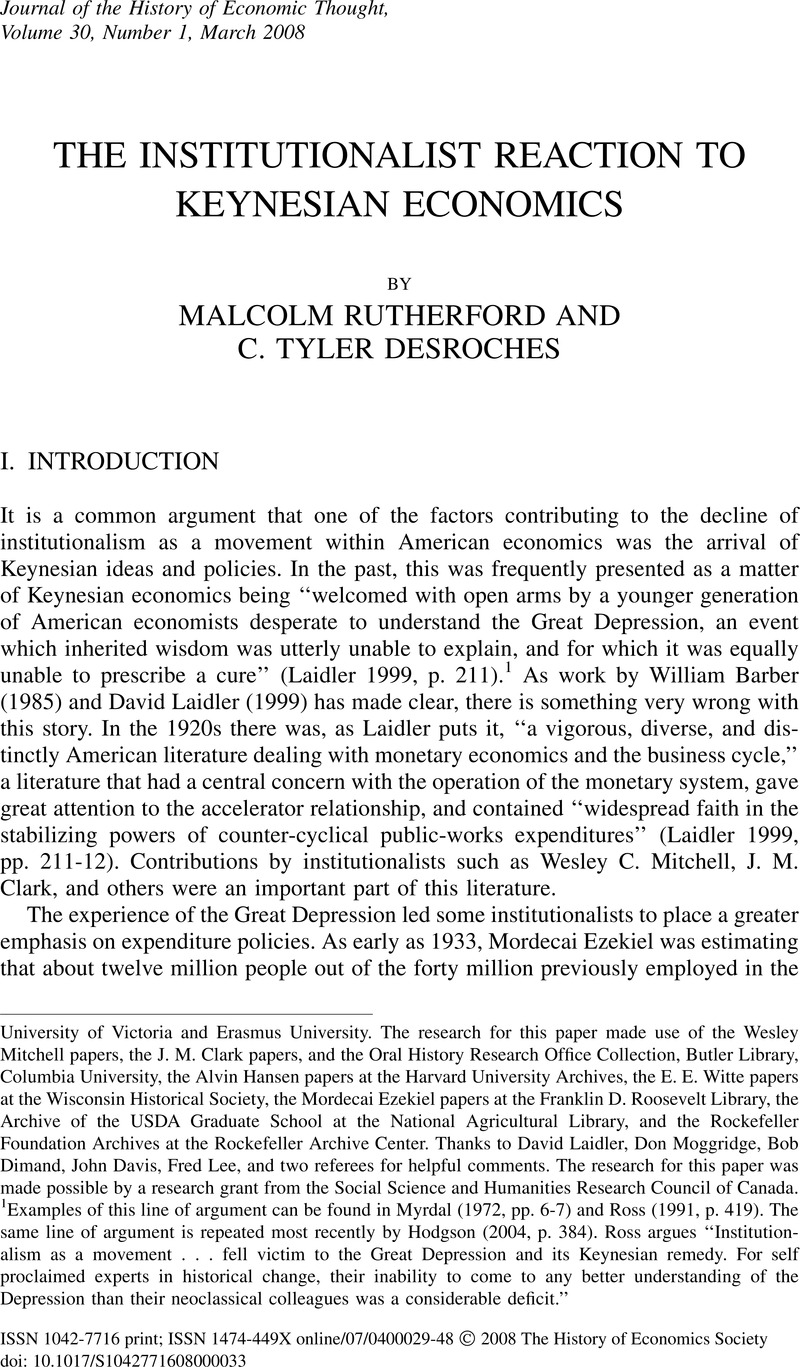Crossref Citations
This article has been cited by the following publications. This list is generated based on data provided by Crossref.
Bateman, Bradley W.
2008.
The New Palgrave Dictionary of Economics.
p.
1.
Fiorito, Luca
and
Vernengo, Matías
2009.
The Other J.M.: John Maurice Clark and the Keynesian Revolution.
Journal of Economic Issues,
Vol. 43,
Issue. 4,
p.
899.
Rutherford, Malcolm
2009.
The USDA Graduate School: Government Instruction in Statistics and Economics, 1921-1945.
SSRN Electronic Journal,
Kaufman, Bruce E. Evan
2011.
Was the Great Depression the Fault of Government and Unions? An Institutional/Keynesian Analysis.
SSRN Electronic Journal,
RUTHERFORD, MALCOLM
2011.
THE USDA GRADUATE SCHOOL: GOVERNMENT TRAINING IN STATISTICS AND ECONOMICS, 1921–1945.
Journal of the History of Economic Thought,
Vol. 33,
Issue. 4,
p.
419.
Kaufman, Bruce E.
2012.
Wage Theory, New Deal Labor Policy, and the Great Depression: Were Government and Unions to Blame?.
ILR Review,
Vol. 65,
Issue. 3,
p.
501.
KAUFMAN, BRUCE E.
2012.
An Institutional Economic Analysis of Labor Unions.
Industrial Relations: A Journal of Economy and Society,
Vol. 51,
Issue. s1,
p.
438.
Johnson, Marianne
2014.
Harold Groves, Wisconsin Institutionalism and Postwar Public Finance.
SSRN Electronic Journal,
Johnson, Marianne
2015.
Harold Groves, Wisconsin Institutionalism, and Postwar Public Finance.
Journal of Economic Issues,
Vol. 49,
Issue. 3,
p.
691.
Bazzoli, Laure
2018.
De l’institutionnalisme du Wisconsin à une perspective macroéconomique aux États-Unis : le cas du débat à l’origine de l’assurance-chômage.
Cahiers d'économie Politique,
Vol. n° 74,
Issue. 1,
p.
63.
Bateman, Bradley W.
2018.
The New Palgrave Dictionary of Economics.
p.
14089.
Rutherford, Malcolm
2019.
Including A Symposium on 50 Years of the Union for Radical Political Economics.
Vol. 37,
Issue. ,
p.
193.
Fang, Hong
Peng, Bo
Wang, Xu
and
Fang, Siran
2019.
The Effect of Intellectual Property Rights Protection in Host Economies on The Sustainable Development of China’s Outward Foreign Direct Investment—Evidence from a Cross-Country Sample.
Sustainability,
Vol. 11,
Issue. 7,
p.
2100.
Johnson, Marianne
2020.
Where Economics Went Wrong: A Review Essay.
Journal of Economic Literature,
Vol. 58,
Issue. 3,
p.
749.
Mourao, Paulo Reis
and
Vilela, Cilina
2020.
‘No country for old men’? The multiplier effects of pensions in Portuguese municipalities.
Journal of Pension Economics and Finance,
Vol. 19,
Issue. 2,
p.
247.
Whalen, Charles J.
2020.
Post-Keynesian institutionalism: past, present, and future.
Evolutionary and Institutional Economics Review,
Vol. 17,
Issue. 1,
p.
71.
Fernández-Huerga, Eduardo
Pardo, Ana
and
Salvador, Ana
2023.
Compatibility and complementarity between institutional and post-Keynesian economics: a literature review with a particular focus on methodology.
Economia Politica,
Vol. 40,
Issue. 2,
p.
413.





